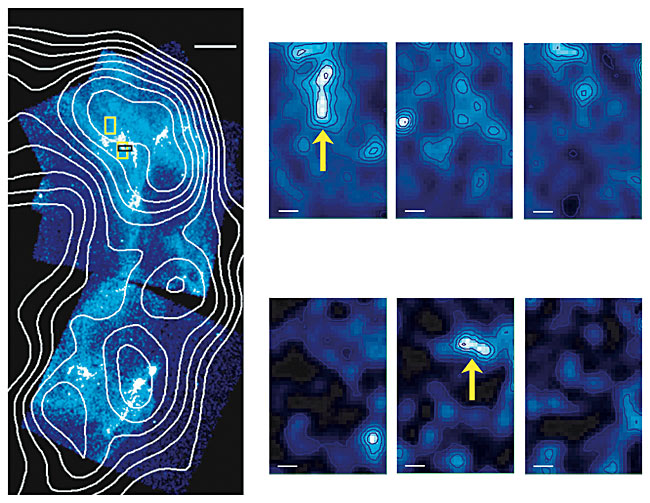Origin of Cosmic Rays Confirmed

Cosmic raysconstantly bombard the Earth as tiny, extremely energetic particles travelingclose to the speed of light, yet their origins have eluded scientists for nearly100 years. A new study, however, brings the mystery a step closer to resolution.
Supernovaremnants—the leftovers of massivestellar explosions—possess magnetic fields much stronger than previouslythought, recent observations of pulsating X-ray hot spots reveal. Scientistssaid the discovery serves as some of the first direct evidence for a system powerfulenough to accelerate particles into cosmic rays.
"Magneticfield strength lies at the heart of cosmic-ray acceleration theory," saidYasunobu Uchiyama, an astrophysicist with the Japan Aerospace ExplorationAgency (JAXA).
Uchiyamaand his colleagues' detail their findings in the Oct. 4 issue of the journal Nature.
Energeticmystery
Cosmic rayswere first discovered in 1912, and since the 1960s scientists have suspected supernovaremnants as their breeding grounds.
Suchremnants travel through interstellar gas as they expand, producing high-speedshockwaves that can generate powerful magnetic fields. As protons, electronsand other charged particles from interstellar gas bounce around in the magneticfields, they're accelerated toblinding speeds to create cosmic rays.
Get the Space.com Newsletter
Breaking space news, the latest updates on rocket launches, skywatching events and more!
Cosmic rayfactories in space work similar to Earth's particle accelerators, yet can pumpparticles with energies tens of thousands of times greater than the largest man-mademachines.
Until Uchiyamaand his team's discovery, however, magnetic fields strong enough to createcosmic rays had never been directly detected.
"Previousestimates of magnetic fields in supernova remnants were based on indirectarguments," Uchiyama said. "In our study, we determine the magneticfield in a direct manner."
X-ray hotspots
To make thediscovery, Uchiyama and his team focused NASA's Chandratelescope on X-ray hot spots in a supernova remnant called RXJ1713.7-3946,located a few thousand light-years from Earth in the constellationScorpius.
The hotspots brightened and faded in less than a year, a variability that is the hallmarkof cosmic ray generation. Because the hot spots barely moved, the astrophysicistswere also able to peg the speed of the supernova shockwave at 10 million mph(16 million kph).
Themeasurement allowed the team to gauge the strength of the remnant'sparticle-accelerating magnetic fields.
"Thisis an extremely important paper," said physicist Don Ellison of North Carolina State University, who was not involved in the study. "This is the firsttime such rapid X-ray variability has been seen in a supernova remnant."
- Top 10 Strangest Things in Space
- VIDEO: Supernova: Creator/Destroyer
- IMAGE: Cosmic Ray-Forming Remnant
Join our Space Forums to keep talking space on the latest missions, night sky and more! And if you have a news tip, correction or comment, let us know at: community@space.com.
Dave Mosher is currently a public relations executive at AST SpaceMobile, which aims to bring mobile broadband internet access to the half of humanity that currently lacks it. Before joining AST SpaceMobile, he was a senior correspondent at Insider and the online director at Popular Science. He has written for several news outlets in addition to Live Science and Space.com, including: Wired.com, National Geographic News, Scientific American, Simons Foundation and Discover Magazine.









